 |
 |
 |
 |
Jump Jump and the Ice Queen

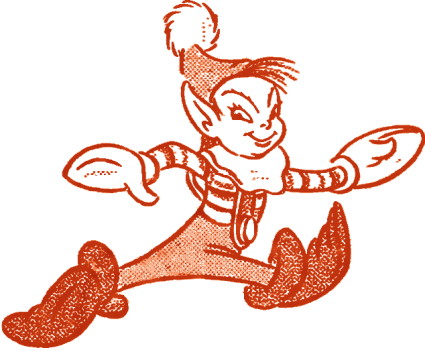 I'm a little elf, no feet three. I'm a little elf, no feet three.
Very, very tiny, as you see.
I never walk, I never run,
I always jump -- it's much more fun!
My name is Jump Jump,
jolly little Jump Jump.
Work is always play.
I'm quick as the wind and my very best friend
Is Mary Holiday!
It's nearly Christmas and a young boy named Tim is worried. Tim is an orphan and his friend Billy is concerned that Santa Claus might prefer to concentrate on "whole families" with mothers and fathers and sisters and brothers and may not visit the orphanage this year. To ease everyone's worries, Tim decides to find the answer once and for all. Late one night, he sets off to find Santa by following the North Star through the woods - but after walking for many hours he gets tired and lies down to take a nap. Imagine his surprise when, awakened by tapping on his knee, he discovers a little boy elf not more than three inches high, jumping from one knee to the other and excitedly gabbing in real elf talk! He soon learns that the elf's name is Jump Jump and that he lives at Holiday House, a place where every day is a holiday. Mary Holiday lives there, too -- and she's Santa's own personal secretary!
So begins "Jump Jump and the Ice Queen," a children's radio series first broadcast in November and December of 1948. Throughout twenty-five imaginative and fantasy-filled episodes, Tim also meets such unique characters as Achi Paggli, the clown who changes his hair color to match his mood, a lion named Sleepy Slim, who is so lazy that he naps far more than he moves, a moody poet who speaks only in rhyme, and, of course, Santa Claus himself -- who asks Tim and his new friends for help in saving Christmas after the selfish Ice Queen kidnaps his reindeer.
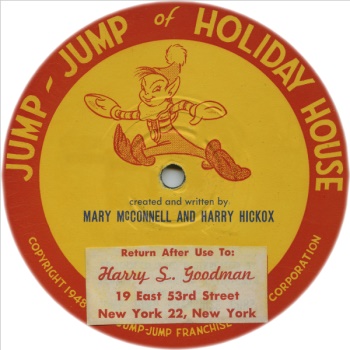 "Jump Jump of Holiday House" was first heard as early as 1940, produced for local station syndication by the New York-based Harry S. Goodman Inc. The series was created and written by Mary McConnell and Harry Hickox, who also contributed their performing talents by playing the majority of the characters on the series. Designed to be aired on a five-a-week basis, with local stations lining up their own local sponsors, "Jump Jump" offered a simple concept: each day, the mischievous little elf would be told a fairy tale by his friend Mary Holiday, complete with specially written songs and appearances by a variety of fun and unusual characters who visited Holiday House on a regular basis. Special programs were written to commemorate individual holidays, and a particular emphasis was placed around Christmas, when local department stores could boost their toy sales through promotions related to the program. (The high-pitched and often unintelligible voice of Jump Jump himself was easily created by recording the voice of an actor at 33 1/3 RPM, then playing it back at 78 RPM; whenever Jump Jump actually needed to be understood by the listener, the actor...would...simply...speak...very...slowly...and...deliberately.) "Jump Jump of Holiday House" was first heard as early as 1940, produced for local station syndication by the New York-based Harry S. Goodman Inc. The series was created and written by Mary McConnell and Harry Hickox, who also contributed their performing talents by playing the majority of the characters on the series. Designed to be aired on a five-a-week basis, with local stations lining up their own local sponsors, "Jump Jump" offered a simple concept: each day, the mischievous little elf would be told a fairy tale by his friend Mary Holiday, complete with specially written songs and appearances by a variety of fun and unusual characters who visited Holiday House on a regular basis. Special programs were written to commemorate individual holidays, and a particular emphasis was placed around Christmas, when local department stores could boost their toy sales through promotions related to the program. (The high-pitched and often unintelligible voice of Jump Jump himself was easily created by recording the voice of an actor at 33 1/3 RPM, then playing it back at 78 RPM; whenever Jump Jump actually needed to be understood by the listener, the actor...would...simply...speak...very...slowly...and...deliberately.)
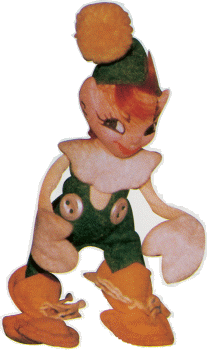 In 1947, entrepreneur Samson R. Diamond came up with the idea of marketing a new series of "Jump Jump" shows to local retailers on a franchise basis, with tie-ins to small dolls based on characters from the show. (Diamond's publishing company, Creative Ideas, had successfully conducted a similar book/merchandise tie-in in 1944, when he hired a twenty-two-year-old free-lance display artist named Rosalind Welcher to co-write an illustrated children's picture book titled "Where is Christmas?") To this end, Diamond made a lease agreement with Harry S. Goodman by which he would hire the creative team of McConnell and Hickox for both their writing and performing skills, then allow Goodman's dynamic and experienced sales force to sell the show in exchange for a reasonable percentage of the resulting profits. Diamond's newly formed Jump Jump Franchise Corporation contracted with a designer named Beatrice to create dolls based on the characters, which were then hand made by the newly incorporated Mattel Toy Company of Culver City, California. Decorative boxes to house the dolls - including a bright yellow cardboard replica of Holiday House - were manufactured by Artwood Products. (Diamond made sure that samples would be available in plenty of time for Goodman's salesmen to show them off to prospective customers during their pre-Christmas summertime sales calls -- hence the 1947 date on the inserts that came with the dolls.) In 1947, entrepreneur Samson R. Diamond came up with the idea of marketing a new series of "Jump Jump" shows to local retailers on a franchise basis, with tie-ins to small dolls based on characters from the show. (Diamond's publishing company, Creative Ideas, had successfully conducted a similar book/merchandise tie-in in 1944, when he hired a twenty-two-year-old free-lance display artist named Rosalind Welcher to co-write an illustrated children's picture book titled "Where is Christmas?") To this end, Diamond made a lease agreement with Harry S. Goodman by which he would hire the creative team of McConnell and Hickox for both their writing and performing skills, then allow Goodman's dynamic and experienced sales force to sell the show in exchange for a reasonable percentage of the resulting profits. Diamond's newly formed Jump Jump Franchise Corporation contracted with a designer named Beatrice to create dolls based on the characters, which were then hand made by the newly incorporated Mattel Toy Company of Culver City, California. Decorative boxes to house the dolls - including a bright yellow cardboard replica of Holiday House - were manufactured by Artwood Products. (Diamond made sure that samples would be available in plenty of time for Goodman's salesmen to show them off to prospective customers during their pre-Christmas summertime sales calls -- hence the 1947 date on the inserts that came with the dolls.)
Once McConnell and Hickox had written the new series - a twenty-five-part Christmas adventure titled "Jump Jump and the Ice Queen," as well as an additional batch of fairy tale-related programs - Diamond hired Bob Mitchell, the station organist at Los Angeles-based NBC affiliate KFI, to perform the show's many musical numbers and background selections. Thanks in part to his creation and nurturing of the famous Mitchell Boy Choir, the multi-talented Mitchell had considerable experience in both working with children and in creating music for juvenile programming -- experience which brought great charm and a warm musical atmosphere to the show.
"Jump Jump and the Ice Queen" and the other programs in the new series were relatively simple to produce, as they involved only three performers: Mary McConnell as Mary Holiday and the Ice Queen, Harry Hickox as all of the male characters (including Santa Claus), and young Johnny McGovern as Tim and Jump Jump -- with the elf's songs, giggles, and individual lines prerecorded and played back at a faster speed. Mitchell provided music on the Hammond organ, as well as arranging for some well-placed harp glissandos, and all of the episodes were recorded and the masters pressed into vinyl by the Allied Record Manufacturing Company by the early part of 1948. When sent out in October of 1948, the discs came complete with cue sheets to assist the engineers who played the discs and who also coordinated the locally-written commercials and opening announcements. The majority of stations would have had a staff announcer read the commercial copy live while the musical portion of the disc was playing in the background - hence the lengthy musical "fill" which is heard both opening and closing each episode.
Here are links to scans of the original Harry S. Goodman Productions cue sheets:
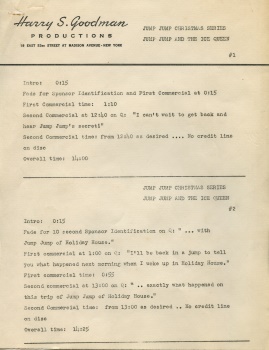 Cues for
Episodes #1 and #2 Cues for
Episodes #1 and #2
Cues for Episodes #3 and #4
Cues for Episodes #5 and #6
Cues for Episodes #7 and #8
Cues for Episodes #9 and #10
Cues for Episodes #11 and #12
Cues for Episodes #13 and #14
Cues for Episodes #15 and #16
Cues for Episodes #17 and #18
Cues for Episodes #19 and #20
Cues for Episodes #21 and #22
Cues for Episodes #23 and #24
Cues for Episode #25 It is not known just how successful the merchandising campaigns associated with the series were, though given the relative rarity of Jump Jump dolls today, it's unlikely to have been as financially lucrative for Diamond as he might have hoped. The series itself, distributed in the U. S. by Harry S. Goodman and in Canada by G. N. MacKenzie and All-Canada Ltd., continued to be heard on small local stations well into the 1960s - though it's apparent that the stand-alone Christmas-oriented "Ice Queen" series quickly became the sole item of interest as the years went by. (There is also evidence to indicate that Jump Jump made his way to one or more early television productions as well.)
Heard today, "Jump Jump and the Ice Queen" may well remind you of the simple but charming children's records produced in the 1940s and 1950s by such companies as Capitol and RCA Victor's Little Nipper Records. (Indeed, Jump Jump himself had appeared with Mary Holiday in "The Ugly Duckling," a 1945 set of commercially released 78 RPM recordings, produced by Bel-Tone Records in Los Angeles, California.) Given that it is a Christmas serial, it is inevitable that comparisons will be made with the better-known "Cinnamon Bear" series, produced in 1937 -- but the two are very different in both concept and execution. Whereas "The Cinnamon Bear" was lavishly produced at the height of network radio with a full orchestra and a large cast, "Jump Jump and the Ice Queen" is a small and intimate affair, relying on the writing and performing talents of a very small cast to capture the attention of the listener and send his or her imagination traveling to many different and exciting places. It's quiet good nature, coupled with effective characterizations and real heart, make this series a pleasure to play and enjoy with the entire family.
A Note on Broadcast Dates: "Jump Jump and the Ice Queen" was designed to be aired Monday thru Friday, so the broadcast dates reflect the first possible airing on local stations; air dates would, of course, have varied from year to year.
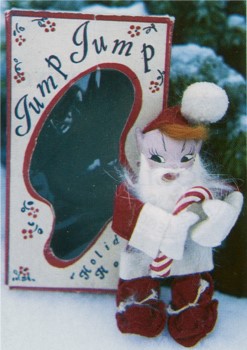 Tim Meets Jump Jump (#1) Tim Meets Jump Jump (#1)
Monday, November 22, 1948 - 15:00 - Syndicated
Sleepy Slim and the Wishing Star (#2)
Tuesday, November 23, 1948 - 15:00 - Syndicated
Traveling to the North Pole (#3)
Wednesday, November 24, 1948 - 15:00 - Syndicated
The Poet (#4)
Thursday, November 25, 1948 - 15:00 - Syndicated
Arriving at the North Pole (#5)
Friday, November 26, 1948 - 15:00 - Syndicated
Santa's Reindeer Kidnapped (#6)
Monday, November 29, 1948 - 15:00 - Syndicated
A Tour of Santa's Workshop (#7)
Tuesday, November 30, 1948 - 15:00 - Syndicated
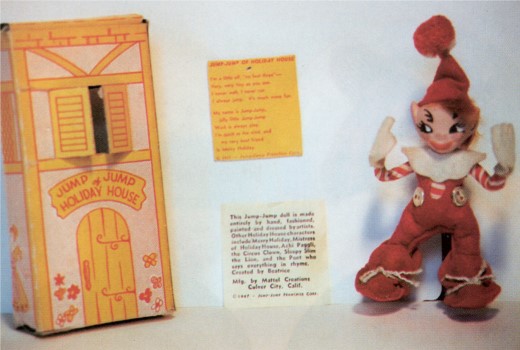 A Doll for Jump Jump (#8) A Doll for Jump Jump (#8)
Wednesday, December 1, 1948 - 15:00 - Syndicated
Rescuing the Rescuer (#9)
Thursday, December 2, 1948 - 15:00 - Syndicated
Jump Jump's Magical Powers (#10)
Friday, December 3, 1948 - 15:00 - Syndicated
Journey to the Ice Queen's Palace (#11)
Monday, December 6, 1948 - 15:00 - Syndicated
Adrift on an Ice Floe (#12)
Tuesday, December 7, 1948 - 15:00 - Syndicated
The Christmas Tree Forest (#13)
Wednesday, December 8, 1948 - 15:00 - Syndicated
The Frozen Country (#14)
Thursday, December 9, 1948 - 15:00 - Syndicated
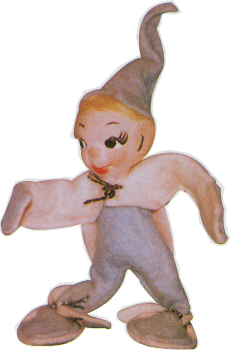 Captured by Ice Dwarfs (#15) Captured by Ice Dwarfs (#15)
Friday, December 10, 1948 - 15:00 - Syndicated
A Crack in the Ice (#16)
Monday, December 13, 1948 - 15:00 - Syndicated
Confronted by Wild Animals (#17)
Tuesday, December 14, 1948 - 15:00 - Syndicated
An Army of Snowmen (#18)
Wednesday, December 15, 1948 - 15:00 - Syndicated
The Palace of the Ice Queen (#19)
Thursday, December 16, 1948 - 15:00 - Syndicated
Tricking the Ice Queen (#20)
Friday, December 17, 1948 - 15:00 - Syndicated
Rescuing the Reindeer (#21)
Monday, December 20, 1948 - 15:00 - Syndicated
Lost in the Palace (#22)
Tuesday, December 21, 1948 - 15:00 - Syndicated
Trapped in the Turret (#23)
Wednesday, December 22, 1948 - 15:00 - Syndicated
The Spirit of Christmas (#24)
Thursday, December 23, 1948 - 15:00 - Syndicated
Back Home Again (#25)
Friday, December 24, 1948 - 15:00 - Syndicated
|
|
 |
 |
 |
 |

|